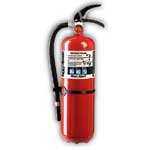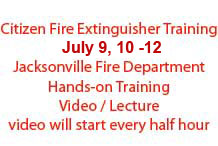 Small fires can be controlled through the use of household or commercial fire extinguishers. A household extinguisher can often completely douse a very small fire and prevent the need for professional assistance. Even if a fire cannot be completely doused, a homeowner can potentially control a blaze long enough with an extinguisher until firefighters arrive. Only proper models of extinguishers should be used. Please note that if the operation of an extinguisher will place you in danger, evacuate the building and wait for fire crews to arrive.
Small fires can be controlled through the use of household or commercial fire extinguishers. A household extinguisher can often completely douse a very small fire and prevent the need for professional assistance. Even if a fire cannot be completely doused, a homeowner can potentially control a blaze long enough with an extinguisher until firefighters arrive. Only proper models of extinguishers should be used. Please note that if the operation of an extinguisher will place you in danger, evacuate the building and wait for fire crews to arrive.
FIRE TYPE: Fire extinguishers are distinguished based on the types of fires on which they are effective. These fires are classified by their fuel source and assigned identifying letters as follows:
“A” class – Fires that result from ordinary combustibles, such as wood and paper.
“B” class – Fires that result from combustible liquids, such as kerosene, gasoline, oil, and grease.
“C” class – Fires of an electrical nature. These result from the combustion of circuit breakers, wires, outlets, and other electrical devices and equipment. Extinguishers designed to handle this type of fire cannot use chemicals that are conductive since conductive agents increase the risk of electric shock to the operator.
“D” class – Fires resulting from combustible metals, such as sodium, potassium, titanium, and magnesium. These fires occur mostly in chemical laboratories and are rare in most other environments.
FOOD FOR THOUGHT: If you do not perform a monthly fire extinguisher inspection on your device, the consequences could be disastrous. If you suspect for any reason that your fire extinguisher is not in good shape, call the fire department to come and inspect it and then follow up each month with a fire extinguisher inspection. Don’t take your fire extinguisher for granted. Performing a monthly fire extinguisher inspection will ensure that it will always be in proper working order. It is also a good idea to have it checked out once a year by a company licensed to perform a more extensive fire extinguisher inspection.
Most people have never done a routine monthly fire extinguisher inspection in part because they aren’t quite sure how to do them or feel it’s unnecessary as long as they have it inspected by a professional yearly. In reality, damage to or loss of pressure in the device could be catastrophic. Spending a few minutes every month could save you a lifetime of heartache so follow these steps below to ensure that your fire extinguisher is in optimal working order.
Steps to Performing a Fire Extinguisher Inspection:
Schedule your fire extinguisher inspection at the same time every month. Keep a calendar next to your extinguisher with a big red X on the date of each month. Generally, you should have one person perform the task each time while another looks on for reference. Have a checklist handy with the date of each fire extinguisher inspection and follow each step until complete. Be sure to mark the date of inspection on the inspection tag.
Your extinguisher should not be blocked by any equipment, coats or objects that may interfere with the access in case of an emergency.
Always check to ensure that the pressure of the unit is at the recommended level by checking the gauge to confirm that the needle is in the green zone.
Make sure the nozzle or other parts of the extinguisher are not obstructed.
If your portable fire extinguishers have a pin and tamper seal, check to see if they are intact and undamaged.
Check for dents, rust, leaks or any sign of abuse or wear. Take a damp rag and wipe off any gunk or chemicals that may have accumulated on the device.
It has been recommended by some manufacturers to shake your extinguisher once a month to prevent the powder from settling on the bottom.
Every few years, your fire extinguisher should be pressure tested to ensure the cylinder is safe to use. Your owner’s manual or extinguisher labels should inform you when yours may need this test. This should be included in your monthly fire extinguisher inspection.
If you notice that your fire extinguisher has become damaged or is in need of a complete recharging, it should be replaced immediately.
VERY IMPORTANT: Immediately after using your fire extinguisher (no matter how much), be sure to do a fire extinguisher recharge on your unit to reach full capacity to ensure that it will be ready in the event of another fire.
If you have any questions about your fire extinguisher feel free to contact us at Jacksonville Fire & Rescue 541-899-7246.